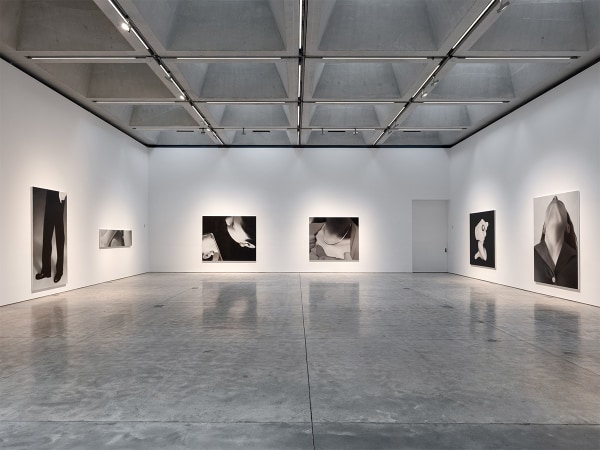George Rickey: Wall Reliefs
-
-
-
"I've been interested in the essence of movement, not just in making objects [that] move, but in trying to use movement as an expressive means, as a painter might use color."
—George Rickey
-
-
Kasmin is thrilled to present a solo exhibition of work by pioneering American sculptor George Rickey. Emphasizing wall-mounted stainless steel kinetic sculptures contextualized by the inclusion of significant free-standing examples from the early 1960s through the 1990s, the presentation draws from the collections of the George Rickey Foundation and the George Rickey Estate, represented by Kasmin since 2020, to demonstrate formal developments in the artist's singular practice over several decades.
-
-

-

-
-
 The artist's studio, East Chatham, NY. © George Rickey Foundation, Inc. / Artists Rights Society (ARS), New York.
The artist's studio, East Chatham, NY. © George Rickey Foundation, Inc. / Artists Rights Society (ARS), New York. -
-

-
-

-
A highlight of the exhibition will be Annular Eclipse - Wall (c. 1995), a unique work related to one of Rickey’s last major sculptures, inspired by an annular eclipse in May 1994—a type of solar eclipse in which the moon is too far from the sun to cover it completely, resulting in a ring of fire around its edge. For the first time in decades, Rickey titled this work after nature, and, in a rare instance in Rickey’s oeuvre, this artwork’s title preceded its conceptual realization. A monumental iteration of Annular Eclipse was installed along Park Avenue in 2000, inaugurating the boulevard’s public art tradition in New York, and then again at the corner of 48th Street and 6th Avenue in 2017.
-
-
-

-
"If great talents use movement, great art will move."
—George Rickey -
George Rickey: Wall Reliefs underscores the relationship between Rickey’s wall-mounted kinetic sculptures and his documented interest in the optical effects of contemporary painting. Beginning his career as a painter, Rickey early on honed his ability to produce artworks at a commanding scale by transforming small gridded sketches into large-scale public murals, an experience that prefigures the monumental sculptures. On a 1961 trip to Europe, around the time he began his “Atropos” series, Rickey met the artists Jesús Rafael Soto and Victor Vasarely in Paris, each known for creating optical effects of movement, and the latter of whose work Rickey would soon acquire for his personal collection. Rickey’s research for his 1967 book Constructivism: Origins and Evolution—which dedicated a chapter to the role of optical phenomena in paintings by Bridget Riley, Vasarely, Soto, and others—would be instrumental in organizing MoMA curator William Seitz’s landmark traveling survey The Responsive Eye in 1965. As Rickey would state about his kinetic sculptures in that year: “I've been interested in the essence of movement, not just in making objects [that] move, but in trying to use movement as an expressive means, as a painter might use color.”
-

-

-
-
 The Rickey apartment and studio, Berlin, 1975. Photo by Achim Pahle. © George Rickey Foundation, Inc. / Artists Rights Society (ARS), New York.
The Rickey apartment and studio, Berlin, 1975. Photo by Achim Pahle. © George Rickey Foundation, Inc. / Artists Rights Society (ARS), New York. -
About the Artist

-
Join our Newsletter
* denotes required fields
We will process the personal data you have supplied in accordance with our privacy policy (available on request). You can unsubscribe or change your preferences at any time by clicking the link in our emails.
-
Explore
-

Alexis Ralaivao: Éloge de l’ombre (In Praise of Shadows)
May 15 – July 25, 2025 509 West 27th Street, New YorkFor Éloge de l’ombre (In Praise of Shadows), Ralaivao unveils a suite of new paintings rendered entirely in black and white. Working within the self-imposed parameters of a reduced palette,... -

Theodora Allen: Oak
May 7 – July 25, 2025 297 Tenth Avenue, New YorkAllen’s atmospheric oil paintings on linen depict natural phenomena and symbols chosen for their enduring presence in human history and culture, often drawing from mythology and medieval imagery. From hearts... -

Alma Allen on Park Avenue
May 2 – September 30, 2025In Alma Allen's largest outdoor installation to date, ten unique bronze and onyx sculptures including examples reaching over 10 feet tall and realized especially for the exhibition, are on view...
-
-
Explore
- Diana Al-Hadid
- Alma Allen
- Theodora Allen
- Sara Anstis
- Ali Banisadr
- Tina Barney
- Judith Bernstein
- JB Blunk
- Mattia Bonetti
- William N. Copley
- Cynthia Daignault
- Ian Davenport
- Max Ernst
- Liam Everett
- Leonor Fini
- Barry Flanagan
- Walton Ford
- Jane Freilicher
- vanessa german
- Daniel Gordon
- Alexander Harrison
- Elliott Hundley
- Robert Indiana
- Lee Krasner
- Les Lalanne
- Matvey Levenstein
- Lyn Liu
- Robert Motherwell
- Jamie Nares
- Nengi Omuku
- Robert Polidori
- Jackson Pollock
- Elliott Puckette
- Alexis Ralaivao
- George Rickey
- James Rosenquist
- Mark Ryden
- Jan-Ole Schiemann
- Joel Shapiro
- Bosco Sodi
- Dorothea Tanning
- Naama Tsabar
- Bernar Venet






















